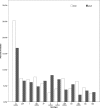Association of serotypes of Streptococcus pneumoniae with age in invasive pneumococcal disease
- PMID: 20107087
- PMCID: PMC2849605
- DOI: 10.1128/JCM.01937-09
Association of serotypes of Streptococcus pneumoniae with age in invasive pneumococcal disease
Abstract
A total of 7,764 isolates from patients with invasive pneumococcal disease (IPD) were collected from 1992 to June 2006. Data on serotypes were available for 5,022 isolates (64.7% of all invasive isolates). Some 54.0% of the isolates originated from adults >or=16 years of age, and 46.0% were from children <16 years of age. The leading serotypes were 14, 23F, 1, 6B, 7F, 3, and 4. The serotypes significantly more common in children were 14, 6B, 19F, and 18C, while among adults, serotypes 3 and 4 were predominant. Serotype 7F was statistically more prevalent among children <4 months old than among the other age groups. Among children aged >or=4 months and <1 year, serotype 19F occurred statistically more frequently; and among children aged >or=1 year to <5 years, serotypes 14, 6B, and 18C were overrepresented. The serotypes predominantly affecting patients younger than the remaining collective of patients were 14, 6B, 19F, and 18C, while patients with IPD caused by serotypes 3, 4, and 9V were older than the collective, on average.
Figures
Similar articles
-
Impact of pneumococcal conjugate vaccines on burden of invasive pneumococcal disease and serotype distribution of Streptococcus pneumoniae isolates: an overview from Kuwait.Vaccine. 2012 Dec 31;30 Suppl 6:G37-40. doi: 10.1016/j.vaccine.2012.10.061. Vaccine. 2012. PMID: 23228356
-
Non-susceptibility trends and serotype coverage by conjugate pneumococcal vaccines in a Tunisian paediatric population: a 10-year study.Vaccine. 2012 Dec 31;30 Suppl 6:G18-24. doi: 10.1016/j.vaccine.2012.07.017. Vaccine. 2012. PMID: 23228353
-
Serotype-specific penicillin resistance of Streptococcus pneumoniae in Germany from 1992 to 2008.Int J Med Microbiol. 2010 Jun;300(5):324-30. doi: 10.1016/j.ijmm.2009.11.004. Epub 2010 Jan 13. Int J Med Microbiol. 2010. PMID: 20071233
-
Global serotype distribution among Streptococcus pneumoniae isolates causing otitis media in children: potential implications for pneumococcal conjugate vaccines.Vaccine. 2009 Jun 12;27(29):3802-10. doi: 10.1016/j.vaccine.2009.04.021. Epub 2009 Apr 25. Vaccine. 2009. PMID: 19446378 Review.
-
Burden of invasive pneumococcal disease and serotype distribution among Streptococcus pneumoniae isolates in young children in Europe: impact of the 7-valent pneumococcal conjugate vaccine and considerations for future conjugate vaccines.Int J Infect Dis. 2010 Mar;14(3):e197-209. doi: 10.1016/j.ijid.2009.05.010. Epub 2009 Aug 22. Int J Infect Dis. 2010. PMID: 19700359 Review.
Cited by
-
Serotype distribution and clinical characteristics associated with streptococcus pneumoniae among Chinese children and adults with invasive pneumococcal disease: a multicenter observational study.Hum Vaccin Immunother. 2021 Jan 2;17(1):146-156. doi: 10.1080/21645515.2020.1757996. Epub 2020 Jun 12. Hum Vaccin Immunother. 2021. PMID: 32530720 Free PMC article.
-
Triptych of the Hermit Saints: pneumococcal polysaccharide vaccines for the elderly.Risk Manag Healthc Policy. 2018 Mar 27;11:55-65. doi: 10.2147/RMHP.S130405. eCollection 2018. Risk Manag Healthc Policy. 2018. PMID: 29636634 Free PMC article. Review.
-
Pneumococcal within-host diversity during colonization, transmission and treatment.Nat Microbiol. 2022 Nov;7(11):1791-1804. doi: 10.1038/s41564-022-01238-1. Epub 2022 Oct 10. Nat Microbiol. 2022. PMID: 36216891 Free PMC article.
-
Serotypes & penicillin susceptibility of Streptococcus pneumoniae isolated from children admitted to a tertiary teaching hospital in Malaysia.Indian J Med Res. 2018 Aug;148(2):225-231. doi: 10.4103/ijmr.IJMR_1987_16. Indian J Med Res. 2018. PMID: 30381546 Free PMC article.
-
Mouse, but not human, ApoB-100 lipoprotein cholesterol is a potent innate inhibitor of Streptococcus pneumoniae pneumolysin.PLoS Pathog. 2014 Sep 4;10(9):e1004353. doi: 10.1371/journal.ppat.1004353. eCollection 2014 Sep. PLoS Pathog. 2014. PMID: 25188225 Free PMC article.
References
-
- Austrian, R. 1981. Pneumococcus: the first one hundred years. Rev. Infect. Dis. 3:183-189. - PubMed
-
- Brueggemann, A. B., T. E. Peto, D. W. Crook, J. C. Butler, K. G. Kristinsson, and B. G. Spratt. 2004. Temporal and geographic stability of the serogroup-specific invasive disease potential of Streptococcus pneumoniae in children. J. Infect. Dis. 190:1203-1211. - PubMed
-
- de Cunto Brandileone, M. C., D. V. V. Simonsen, S. Tadeu Casagrande, R. Cobo Zanella, M. L. Leopoldo Silva Guerra, A. Pires Brandao, C. E. de Andrade Melles, A. C. C. Pignatari, J. L. Di Fabio, and R. Austrian. 1998. Characteristics of isolates of Streptococcus pneumoniae from middle-aged and elderly adults in Brazil: capsular serotypes and antimicrobial sensitivity to invasive infections. Braz. J. Infect. Dis. 2:90-96. - PubMed
-
- Feikin, D. R., and K. P. Klugman. 2002. Historical changes in pneumococcal serogroup distribution: implications for the era of pneumococcal conjugate vaccines. Clin. Infect. Dis. 35:547-555. - PubMed
-
- Feikin, D. R., K. P. Klugman, R. R. Facklam, E. R. Zell, A. Schuchat, and C. G. Whitney. 2005. Increased prevalence of pediatric pneumococcal serotypes in elderly adults. Clin. Infect. Dis. 41:481-487. - PubMed
Publication types
MeSH terms
LinkOut - more resources
Full Text Sources
Medical
Molecular Biology Databases


